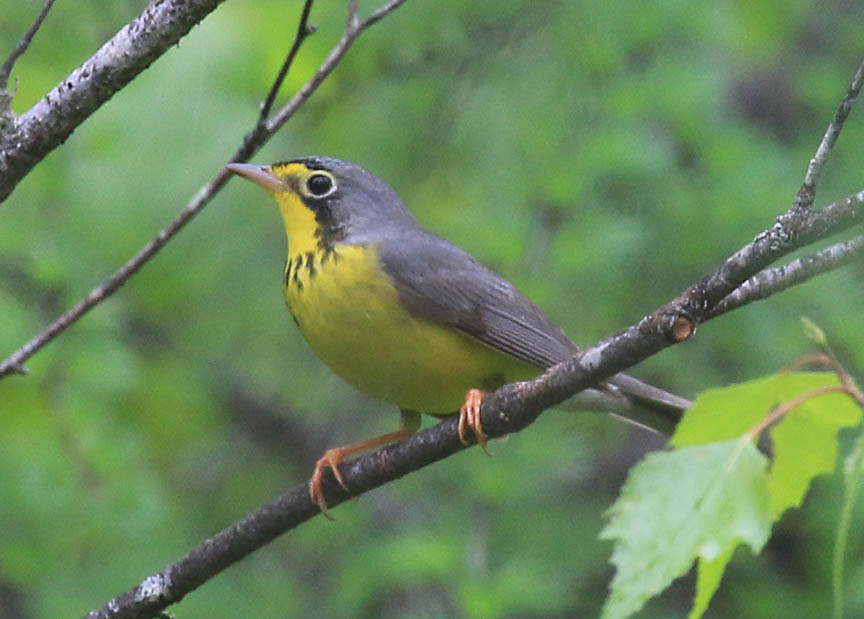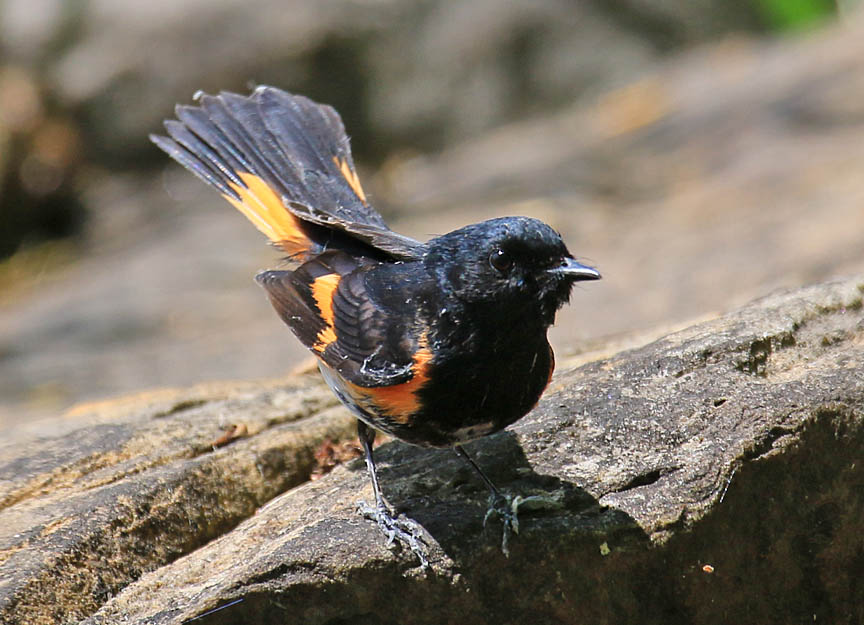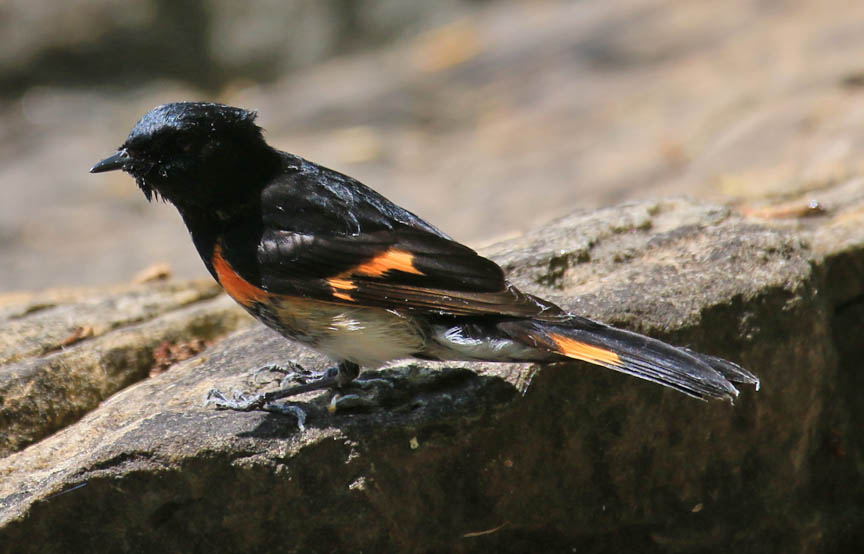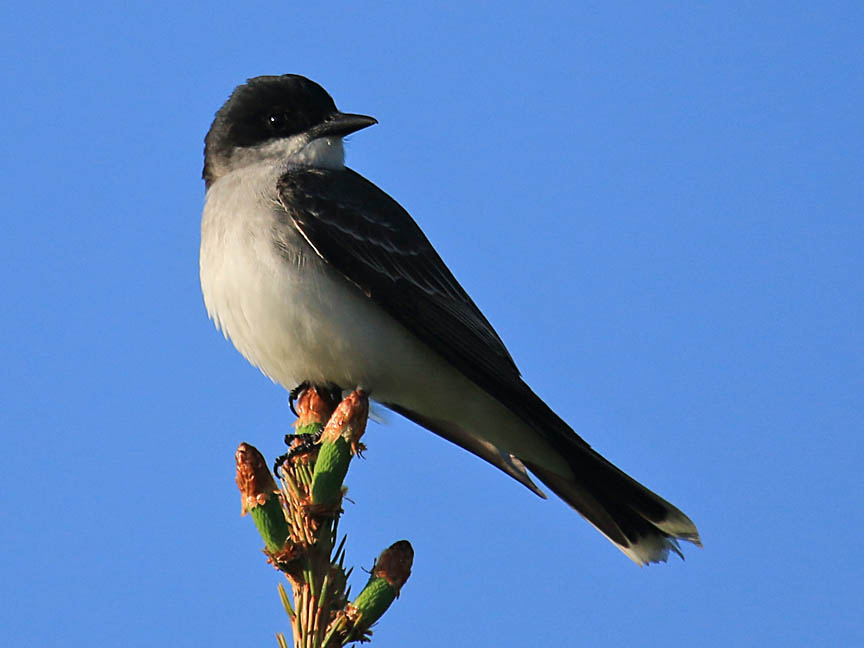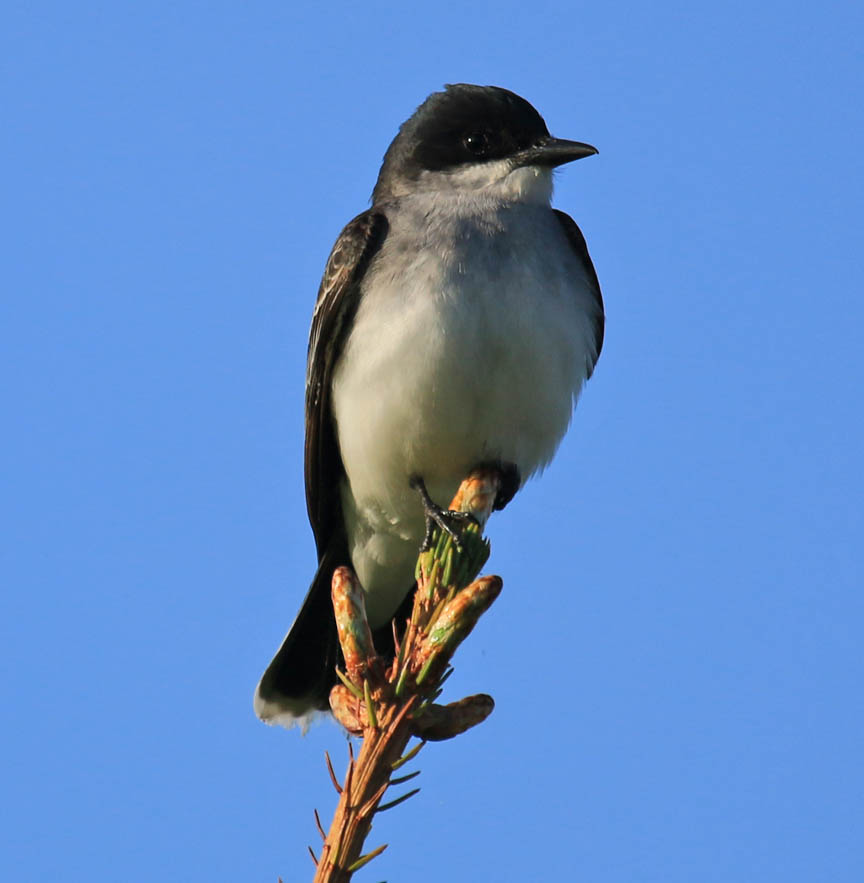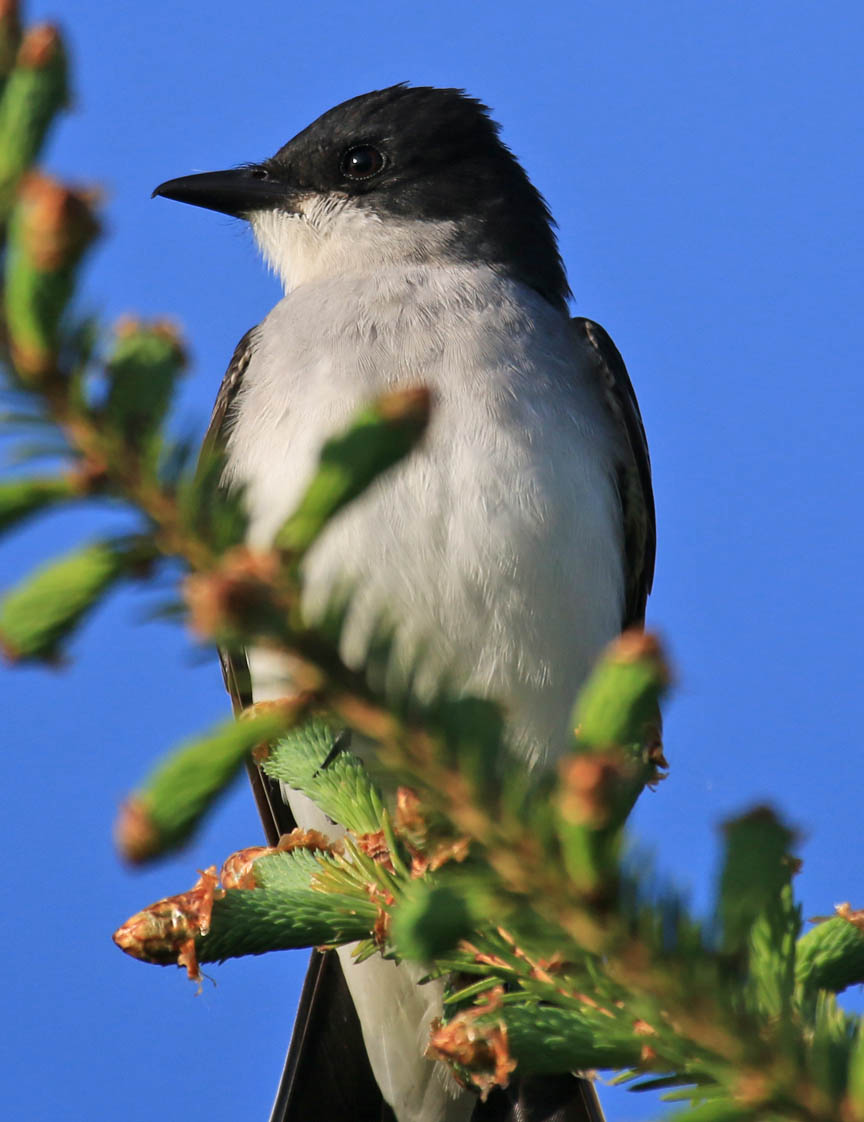This post is a bit birdy-wordy so, if you have the attention span of a Hamster, no names, no pack drill, just take a glance at this appalling photo of a Wood Thrush from yesterday and move on…
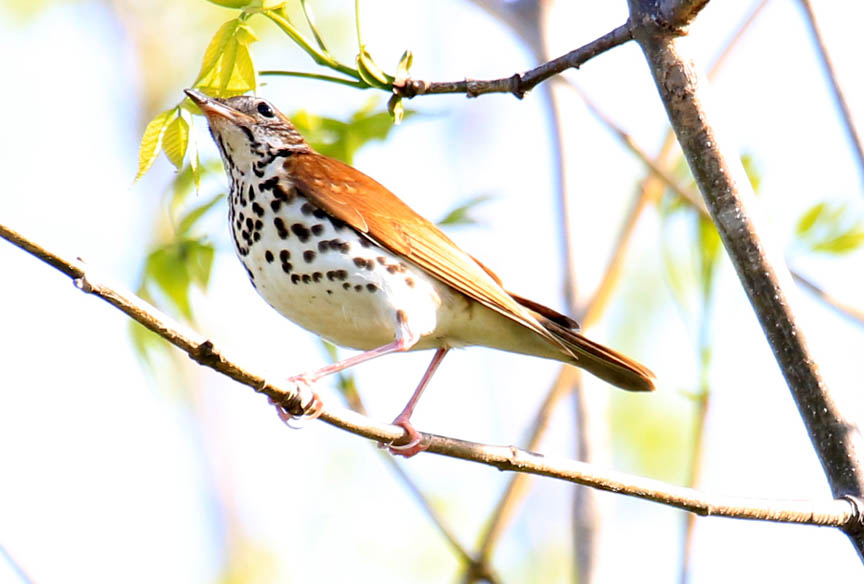
On the spur of the moment, Greg Rand and I decided to have a bit of a day out locally, see what we could find and just enjoy the spring migration. For me it was a chance to visit some favourite sites around southern Quebec, perhaps for the last time. Some of the sites would be new for Greg and so, with this dual motivation, we met up at 04:30, intending to hit the hot spots by dawn.
I’ll cut to the chase, we managed 124 species that we both recorded and Greg had two others that I missed due to age and infirmity. We almost certainly both saw Bank Swallow too, but never really isolated one until it was too late. Looking at what we might have seen, well it could have been a bigger day
Here are the 43 species we might have got with a bit better luck (and judgement). * are the ones Greg got that I didn’t. I added a few helpful comments.
Green Heron – Not many around, only seen one so far this year.
Black-crowned Night-Heron – should have found at least one.
Least Bittern – On the edge of arrival so forgivable.
Blue-winged Teal – Hit and miss but we looked at enough water to see one.
Lesser Scaup – Don’t know where they have all got to.
Hooded Merganser – Sneaky in breeding season.
Common Merganser – There a few days ago.
Bald Eagle – A nice day for a flap but they didn’t oblige.
Sharp-shinned Hawk – Hard at times.
Cooper’s Hawk – You need luck or a nest.
Red-shouldered Hawk – Doh!
Broad-winged Hawk – Not many in our area and migrants have already gone through.
Merlin – Quiet when they are breeding.
Semipalmated Sandpiper – Should have seen one, maybe we did but some shorebirds were distant and wobbly in the heat haze.
Pectoral Sandpiper – AWOL!
Dunlin – Only a possible.
Semipalmated Plover – Just strangely absent.
Bonaparte’s Gull – Perhaps too far out to see.
Caspian Tern – Only the odd one around at the moment.
American Black Tern – St-Timothee should have them but not so far.
Eastern Screech-Owl – Needed to luck in with one.
Great Horned Owl – Outside chance when we were listening to Eastern Whip-poor-wills.
Barred Owl – Possible.
Eastern Wood-Pewee* – Too far off for me but Greg’s bionic ears picked one up.
Philadelphia Vireo – Where were you?
Cedar Waxwing – Sneaky little beggars.
Swainson’s Thrush – Should have found one really.
Brown Creeper – Another luck job.
Winter Wren – Same as above.
Tufted Titmouse – Need one calling or feeders to remain full!
Bank Swallow – Never pinned down but we probably did see one amongst the high flying flocks of hirundines.
Ruby-crowned Kinglet – Strange we didn’t connect.
Golden-crowned Kinglet – Still need it for the year.
Horned Lark – Need to make a noise or move in the ploughed expanses.
Pine Siskin – They are lingering after their winter arrival.
Lincoln’s Sparrow – Always the scarce one.
Blackburnian Warbler – Not playing the game. Greg thought he heard one but was suffering sensory overload by then.
Pine Warbler* – One called as I dropped Greg off.
Blackpoll Warbler – A tad early but not impossible.
Mourning Warbler – Quite possible.
Wilson’s Warbler – Earlyish.
Canada Warbler – Arriving so possible.
Indigo Bunting – The invisible bunting. Should have been in.
Rusty Blackbird – One sang from the local bog the day before.
House Finch – Should have had one somewhere.
Those 43 species would have turned the day into something else altogether. Some we needed to connect with while we were at specific sites, others we could have tried for but ran out of beans really. Now you know the bad, moving on to the good.
We hadn’t intended to do a big day of any sort, but it just evolved that way after the success of getting Eastern Whip-poor-will onto the list first. That was at St-Lazare sand pits and from there we headed out Huntingdon way, selecting Montee Biggar as our dawn chorus location.
It was a good choice, the place was alive with bird song and activity and held a few surprises. The first surprise was when five Common Loons flew over. We might have reasonably expected to find one on the waters of Beauharnois later (we didn’t), but five going low over the woods were a bit surreal. The second surprise came after we’d picked our way along the road and had had good looks at two Brewster’s Warblers, hybrids between Golden and Blue-winged Warbler. Neither had been banded, unlike ones I’d seen there previous, so where were the rarer of their parents, blue-winged, hanging out?
We’d done the road and were about to move on when more warbler activity became obvious a little up the hill from where we’d parked. Cape May Warblers had started showing, along with several other species, so we settled in to look for those we’d not seen yet when Greg picked up a different song amidst the chorus. This was no mean feat given that the Rose-breasted Grosbeaks were doing their version of duelling banjos everywhere, along with all the other noisy blighters. The ‘interesting’ bird sang again and I could hear it too, but not very well and not filtered enough from the ‘chaff’ to form an opinion. Greg thought it was from the Connecticut area of the warbler list, it was time for playback.
Before some of you start shaking their heads, this was a migrant, not a breeder, and we needed to confirm the identification, not to it, obviously, it knew it was a Connecticut, but to us who were a bit disbelieving. A few bursts encouraged the bird to give a clear sequence of song and showed that it was getting closer. Greg then had a brief view in the tangles and I saw the bird fly but that was all we could get visually. After another brief period of song it shut up, as they do, and we left it alone. For the second successive year I’d had a Connecticut Warbler on migration after only seeing one previously, isn’t birding just full of these odd little coincidences.
We had made a good start, very good actually, and so decided to keep going along and then to see whether we would need to make some effort later, there was still some way to go and the birds would be feeling the cold wind just as we were, would they play ball?
We meandered around several sites in the area, adding the odd bird but also lamenting the lack thereof, in an area normally blessed with Field Sparrows we were coming up blank, similarly with Indigo Bunting. We spent some time seeking out a buzzer that turned out to be a male Golden-winged Warbler, although the song was nearer Blue-winged so you have to wonder where this was a Lawrence’s Warbler – another hybrid that makes finding a pure one that much harder, we did though.
We found our first biting insects on Gowan Road, a very reliable site for them. The birds there were less so accommodating but we added a few, not enough to keep us there though. Upland Sandpiper is one of those enigmatic species and it is fast disappearing due to farming being about dollars and not responsibility, still, there are a few left in Hitchinbrooke and we found one – much to our relief. After a bit of a cruise around for Eastern Bluebirds, it was off to the Great Egret Trail at Dundee where a crane awaited.
We walked to the small woodlot at Dundee where the viewing thing is, taking in Sandhill Crane, Willow Flycatcher and a good flock of warblers and vireos on the way. The woods were noisy with song and, in amongst the sweeter singing Red-eyed Viroes were the whiskey drinking versions of Yellow-throated Vireo, a tough Quebec find, we had two and again thanks to Greg’s aural perspicacity. We stocked up with most of the available species but found the place wanting for ducks and the previously regular gnatcatchers, we moved on.
Now we were heading homewardsish. Dundee had supplied copious numbers of Purple Martins so we had no need to search for them on the way. We were heading for Hungry Bay on the off-chance of a sea duck, what we got was a Red-bellied Woodpecker. On the way we decided to check out a new water purification station and, as I slowed down to make the turn with my indicator blinking away, the image in the rear view mirror was off a truck driver braking hard and slewing a bit. He managed to pull up in time, so there was no need to get out after having been tail-ended and deliver the inevitable smiting with a tripod.
The woodpecker was a bonus and perhaps a sign, so we took in a number of sites on the way to the fabled St-Timothee Marsh. Fabled, because it is good for birds and so it proved. Fabled too for the lack of management and, I will say it again, the idiot planting of shrubs where the phragmites suppressing matting is stupid, whoever did this is a complete fool. It was warm now, we’d not had the hoped for Bonaparte’s Gulls and Caspian Tern at nearby Melocheville, but we’d done ok.
Our first refreshment stop was at a Tim Horton’s (obviously), where sugary treats gave us an energy boost to push on. The objective now was to clean up a few species at St-Lazare sand pits, Field Sparrow, Belted Kingfisher and Bank Swallow, we made two out of three.
After 13.5 hours in the field it was enough and I dropped Greg off. The day was done, the birds heard and seen and the total unclear until un-fuzzed brains could unravel the day via Excel, eBird and hastily scrawled notes. Below is the species list with comments. There is every chance that this was my last big day in Quebec, unless tomorrow gets off to a good start, then we’ll see how it goes.
Thanks to Greg for excellent company in a great birding day and for sharing his relatively young ears, he’s older than he looks you know!
The systematics of the list are a bit arse-about-face (translation, a bit wrong) but that won’t bother an experienced birder like you, also, if I call it a ‘given’ it means that you’d expect to see the species if you visit the habitat.
Pied-billed Grebe – A given.
Common Loon – As already mentioned, quite a surprise the way we saw them.
Double-crested Cormorant – A given.
Great Blue Heron – A given.
Great Egret – A given.
American Bittern – “Ker-plunked” at St-Timothee, then one flew over.
Turkey Vulture – A given.
Snow Goose – Lingering birds that may or may not be carrying some shot.
Canada Goose – A given.
Wood Duck – A given.
American Wigeon – We were lucky with three together at one site.
Gadwall – A given.
Green-winged Teal – Lots at one site only.
Mallard – A given.
Northern Shoveler – Lucky really, not normally around in mid-May.
Redhead – Breed but can be naughty to see.
Ring-necked Duck – A given.
Common Goldeneye – A few left where there were lots a week ago.
Osprey – A given.
Northern Harrier – A given.
Red-tailed Hawk – A given.
American Kestrel – A given.
Peregrine Falcon – A given.
Ruffed Grouse – Thumped away like a good boy.
Virginia Rail – Got to make a noise and they did.
Sora – Likewise, ore chance of hearing one that tripping over it.
Common Gallinule – A given.
Sandhill Crane – A given.
American Woodcock – Nocturnal, more or less.
Wilson’s Snipe – Only a couple drumming or chirping.
Upland Sandpiper – A treasure and one we looked hard for.
Greater Yellowlegs – Only one seen.
Lesser Yellowlegs – A few around but not always the case on a big day.
Solitary Sandpiper – A few where they were expected to be, read the script.
Spotted Sandpiper – A given.
Least Sandpiper – Shorebirds can be hit or miss, this species was well behaved, this time!
Killdeer – A given.
Ring-billed Gull – A given, no really!
Great Black-backed Gull – A given.
American Herring Gull – Sometimes tricky.
Common Tern – A given.
Rock Pigeon – A given.
Mourning Dove – A given.
Eastern Whip-poor-will – Got to be there are the right hour.
Chimney Swift – Quite local at times although we did well.
Ruby-throated Hummingbird – Very hit or miss.
Belted Kingfisher – Just the one, which was odd.
Red-bellied Woodpecker – A complete surprise and evidence of their spread in QC.
Yellow-bellied Sapsucker – A given.
Downy Woodpecker – Buggers at times.
Hairy Woodpecker – A bit noisier than Downy but can be missed.
Northern Flicker – A given.
Pileated Woodpecker – One flying over fields was not expected.
Alder Flycatcher – First birds back, more or less.
Willow Flycatcher – First bird back again, just the one.
Least Flycatcher – A few around but you want some noise from them.
Eastern Phoebe – Can be tricky, didn’t see one when we did 163 a few years ago.
Eastern Kingbird – A given.
Blue-headed Vireo – Just the one seen.
Yellow-throated Vireo – Lucky, lucky is all I can say.
Red-eyed Vireo – A given.
Warbling-Vireo – A given.
Blue Jay – A given.
American Crow – A given.
Common Raven – A given.
Eastern Bluebird – Sneaky at times, took some looking for.
Veery – If they make a noise you’ve got them.
Hermit Thrush – Only a couple I think.
Wood Thrush – In previous years tricky, this year abundant.
American Robin – A given.
Common Starling – A given.
Grey Catbird – Almost a given, of go on then, a given!
Brown Thrasher – Only one obliged.
Red-breasted Nuthatch – Two where they were not expected to be, that’s all.
White-breasted Nuthatch – Should be a given really.
Marsh Wren – A given.
House Wren – Only one found.
Black-capped Chickadee – A given.
Tree Swallow – A given.
Purple Martin – A given.
Northern Rough-winged Swallow – Only one seen I think, a bit local at times.
Barn Swallow – A given.
Cliff Swallow – A given.
House Sparrow – A given.
American Goldfinch – A given.
Purple Finch – A couple found.
Song Sparrow – A given.
Swamp Sparrow – A given.
White-crowned Sparrow – Either there or not, we saw lots.
White-throated Sparrow – A given.
Savannah Sparrow – A given.
Chipping Sparrow – A given.
Field Sparrow – Only one found, old faithful at St-Lazare, eventually.
Vesper Sparrow – Tricky, you need to know where to look.
Eastern Towhee – A given if you go to the right places.
Brewster’s Warbler – Not counted as a species but interesting to see two different birds.
Golden-winged Warbler – Tricksy at times.
Tennessee Warbler – Abundant, or so said Greg’s ears. Saw a few too.
Nashville Warbler – Local, we only had one.
Northern Parula – Lucked in with two at one site.
Yellow Warbler – A given.
Chestnut-sided Warbler – A given.
Magnolia Warbler – A given.
Cape May Warbler – Several of these beauties.
Black-throated Blue Warbler – A few found, mostly vocalisations.
Yellow-rumped Warbler – Lots around, a given really.
Black-throated Green Warbler – Found at a few places.
Palm Warbler – One seen, can be a little tricky.
Bay-breasted Warbler – A fine male at one site, a few others heard by Greg elsewhere.
Black-and-White Warbler – A given.
American Redstart – A given.
Ovenbird – A given.
Northern Waterthrush – A given.
Connecticut Warbler – Well, what can you say, a great bird to get on a big day.
Common Yellowthroat – A given.
Scarlet Tanager – A given.
Rose-breasted Grosbeak – A given.
Northern Cardinal – A given.
Baltimore Oriole – A given.
Red-winged Blackbird – A given.
Eastern Meadowlark – Local but a bit of a given if you know what you are doing.
Common Grackle – A given.
Brown-headed Cowbird – A given.
Bobolink – A given.
Good eh?






























